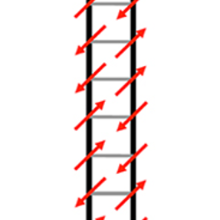Magnetic properties of low-dimensional spin systems
One-dimensional chains constitute a textbook example of interacting spins that is treated numerically and analytically. Although real solids are three dimensional, the exchange interactions between spins can become so strongly anisotropic that effectively one dimensional or two dimensional spin arrangements are realised. Varying the interaction leads to a rich phase diagram, which can be manipulated by magnetic field or external pressure. In addition, introduction of disorder by chemical substitution can break the continuity of the spin chains and hence is another interesting route to manoeuvre the magnetic state of these systems.
In this project, we will investigate magnet using bulk magnetization measurements in Superconducting Quantum interference Device (SQUID) magnetometer and electron spin resonance (ESR) technique in the temperature range of 2-300 K.
References
- Motoyama, T. Osafune, T. Kakeshita, H. Eisaki, and S. Uchida, Phys. Rev. B 55, (1997)
- T. Vuletic, B Korin-Hamic, T Ivek, S. Tomic and B. Gorshunov, M. Dressel and J. Akimitsu, Physics. Report 428 (2006)
- Rabindranath Bag, Koushik Karmakar, Sudesh Dhar, Malvika Tripathi, R J Choudhary and Surjeet Singh, J. Phys. Condens. Matter 31, (2019) 035801
- Shiroka et als, Phys. Rev. B 99, 035116 (2019)
Contact

Sudip Pal
Dr.Electron Spin Resonance

Martin Dressel
Prof. Dr. rer. nat.Head of Institute



